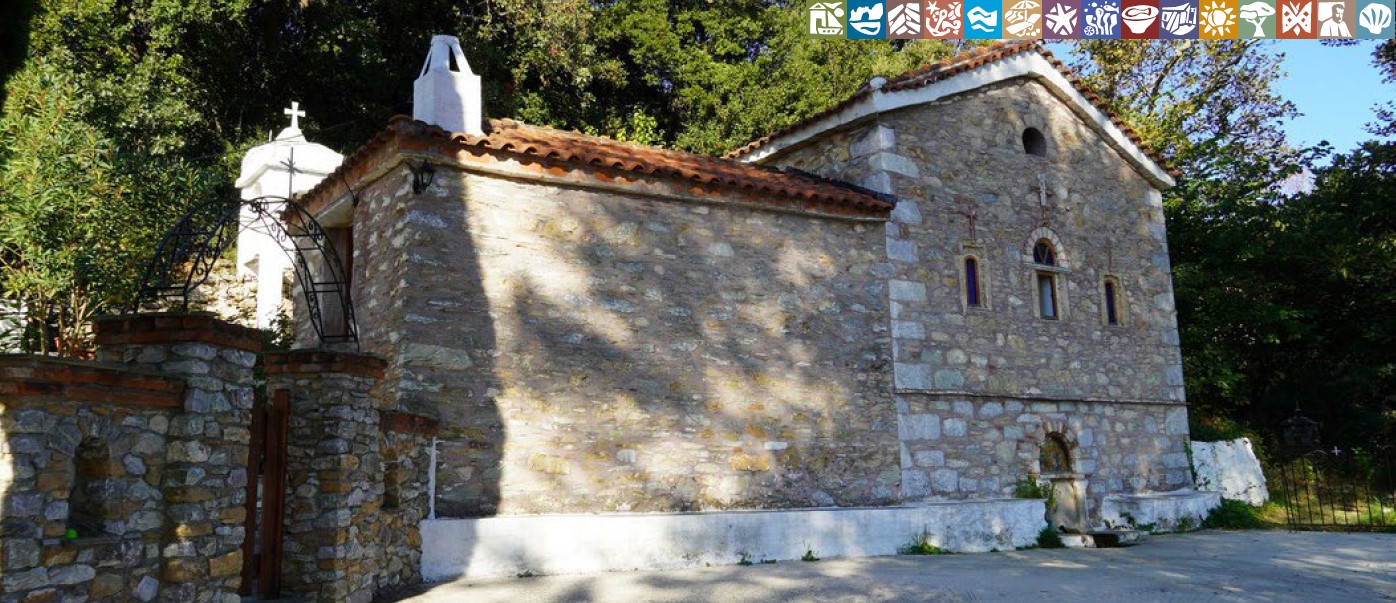
Holy Sites
on the holy sites, whether that is the Cathedral with its imposing marble
iconostasis or the iconic monastery of Evangelistria with the fortified
architecture of Mount Athos or the small modest chapels.
of the post-byzantine monuments” was indispensable for
recording and scientifically substantiating the places of
worship in Skiathos.
Most of the churches were built during the post-byzantine era
(1821-1453). Only two belong to a previous era, Agia Triada
(Holy Trinity) and Hagia Sophia in Troulos. The church of Agios
Sozon or Ai Sostis was the only one built in the 19th century
and the rest were of the 20th and 21st century. The postbyzantine
churches and Monasteries are the most interesting
in their characteristics and we can divide them in:

The first, that pertains to nearly all the churches, is native,
folk, austere and affected by the neighbouring Pelion which
is flourishing at the time (enlightenment). The second, richer
in form and more considered, involves elements of the
architecture of the Holy Mount Athos. A typical monument of
this tradition is the Monastery of Evangelistria, the founder
of which came from the Holy Mount. This second tradition
can be seen in the rest of the Sporades as well.
Iconographic decoration is present only in five monuments (catholicons of the monasteries of Panagia Kechria, Panagia Iconistra, Agios Ioannis Parthenis, Evangelistria and Christos sto Kastro). It is certain, though, that there was iconographic decoration in other churches of the island (Glykofilousa, catholicon of Evangelismos outside Kastro, Panagia Prekla, Panagia Kardasi) something verified by both the few remaining traces of murals and by some of Papadiamantis’ novels, since he probably saw the murals before they perished. Of the ones that remain, the oldest belong to Christos sto Kastro and they are probably the best from an artistic point of view. Overall, the murals are considered to be of medium to great art, with no particular style. Unfortunately, we don’t know the names of the artists that worked on the decorative elements of the churches, because the inscriptions have been lost. The only iconographers we know are the ones that worked in the catholicon of the Monastery of Evangelistria.
The altarpieces have simple forms and most are created by craftsmen with no particular technical training. Nonetheless, there are notable wood carved altarpieces, masterfully and diligently made, in the inside of churches dating from the end of the 17th century (Christos sto Kastro). There is even one earlier specimen, dating from 1674, in Panagia Prekla.
The most noteworthy churches in Skiathos are the ones in Kastro as well as the Monasteries and their catholicons.
The churches of Kastro were directly related to the life of Skiathians during the Turkish rule. It is a given that the lifestyle and the habits typical of the locals of the time affected amongst other things the way the places of worship were constructed.
The alternation between the Turks and Venetians in the ruling of Skiathos, combined with the violent occupations of the island, the frequent pirate raids and the devastation that followed, the constant moving of the residents and the peculiar morphology and narrowness of the space available in the area occupied by the town of Kastro didn’t favour the construction of big churches. Consequently, a lot of small chapels were built inside Kastro (more than 20, according to tradition). Lack of data and the state of derelict Kastro don’t allow us to pinpoint the exact place of all the churches in the settlement. We assume that each church was the centre around which a group of houses was built. Most should have belonged to families, a tradition that carries on to our day. The churches took after the small and low houses of Kastro. Financial reasons and lack of space attest to the construction of simple churches without any particular morphological and decorative features.
During the 18th century, there is a tendency of constructing, expanding, renovating or decorating churches that were far from Kastro, a tendency that might have been supported by a potential economic growth of the island, following the example of other Aegean islands.
After 1829, the residents of Skiathos are more interested in the construction of their new residences in their new settlement -which is the town of Skiathos to this day. After a whole decade, they built the first big church of the island, Panagia, and a bit later the church of the Three Holy Hierarchs, at a time when the Greek state had been reorganised and established.
The clergy played the biggest part in the founding of churches, without excluding the case of locals contributing to the reconstruction or renovation of churches.
Most of the churches in Skiathos were built during the Turkish rule up until 1850. Today there are very few remains of churches belonging to the pre-turkish rule era.



